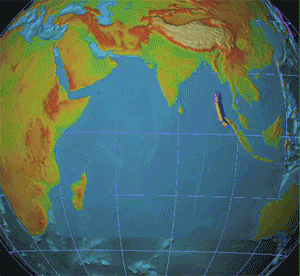From Wikipedia, the free encyclopedia https://en.wikipedia.org/wiki/2004_tsunami
|
Tsunami strikes Ao Nang, Thailand. | |
| Date | 00:58:53, 26 December 2004 (UTC)[1] |
|---|---|
| Magnitude | 9.1–9.3 Mw[1] |
| Depth | 30 km (19 mi)[1] |
| Epicenter | 3°18′58″N 95°51′14″E / 3.316°N 95.854°ECoordinates: 3°18′58″N 95°51′14″E / 3.316°N 95.854°E[1] |
| Type | Undersea (subduction) |
| Countries or regions | Indonesia (mainly in Aceh) Sri Lanka India (mostly in Tamil Nadu) Thailand Maldives Somalia |
| Tsunami | Yes |
| Casualties | 230,210 – 280,000 deaths[2][3][4] |
The earthquake was caused when the Indian Plate was subducted by the Burma Plate and triggered a series of devastating tsunamis along the coasts of most landmasses bordering the Indian Ocean, killing over 230,000 people in fourteen countries, and inundating coastal communities with waves up to 30 meters (98 ft) high.[8] It was one of the deadliest natural disasters in recorded history. Indonesia was the hardest-hit country, followed by Sri Lanka, India, and Thailand.
With a magnitude of Mw 9.1–9.3, it is the third largest earthquake ever recorded on a seismograph. The earthquake had the longest duration of faulting ever observed, between 8.3 and 10 minutes. It caused the entire planet to vibrate as much as 1 centimetre (0.4 inches)[9] and triggered other earthquakes as far away as Alaska.[10] Its epicentre was between Simeulue and mainland Indonesia.[11]
The plight of the affected people and countries prompted a worldwide humanitarian response. In all, the worldwide community donated more than $14 billion (2004 US$) in humanitarian aid.[12]

Earthquake characteristics
The earthquake was initially documented as moment magnitude 8.8. In February 2005 scientists revised the estimate of the magnitude to 9.0.[13] Although the Pacific Tsunami Warning Center has accepted these new numbers, the United States Geological Survey has so far not changed its estimate of 9.1. The most recent studies in 2006 have obtained a magnitude of Mw 9.1–9.3. Dr. Hiroo Kanamori of the California Institute of Technology believes that Mw 9.2 is a good representative value for the size of this great earthquake.[14]The hypocentre of the main earthquake was approximately 160 km (100 mi), in the Indian Ocean just north of Simeulue island, off the western coast of northern Sumatra, at a depth of 30 km (19 mi) below mean sea level (initially reported as 10 km (6.2 mi)). The northern section of the Sunda megathrust, ruptured; the rupture having a length of 1,300 km (810 mi).[11] The earthquake (followed by the tsunami) was felt simultaneously in Bangladesh, India, Malaysia, Myanmar, Thailand, Singapore and the Maldives.[15] Splay faults, or secondary "pop up faults", caused long, narrow parts of the sea floor to pop up in seconds. This quickly elevated the height and increased the speed of waves, causing the complete destruction of the nearby Indonesian town of Lhoknga.[16]
Great earthquakes such as the Sumatra-Andaman event, which are invariably associated with megathrust events in subduction zones, have seismic moments that can account for a significant fraction of the global earthquake moment across century-scale time periods. Of all the seismic moment released by earthquakes in the 100 years from 1906 through 2005, roughly one-eighth was due to the Sumatra-Andaman event. This quake, together with the Good Friday Earthquake (Alaska, 1964) and the Great Chilean Earthquake (1960), account for almost half of the total moment. The much smaller but still catastrophic 1906 San Francisco earthquake is included in the diagram below for perspective. Mw denotes the magnitude of an earthquake on the moment magnitude scale.
Since 1900 the only earthquakes recorded with a greater magnitude were the 1960 Great Chilean Earthquake (magnitude 9.5) and the 1964 Good Friday Earthquake in Prince William Sound (9.2). The only other recorded earthquakes of magnitude 9.0 or greater were off Kamchatka, Russia, on 4 November 1952 (magnitude 9.0)[17] and Tōhoku, Japan (magnitude 9.0) in March 2011. Each of these megathrust earthquakes also spawned tsunamis in the Pacific Ocean. However, the death toll from these was significantly lower, primarily because of the lower population density along the coasts near affected areas and the much greater distances to more populated coasts and also due to the superior infrastructure and warning systems in MEDCs (More Economically Developed Countries) such as Japan.
Other very large megathrust earthquakes occurred in 1868 (Peru, Nazca Plate and South American
Plate); 1827 (Colombia, Nazca Plate and South American Plate); 1812 (Venezuela, Caribbean Plate and South American Plate) and 1700 (western North America, Juan de Fuca Plate and North American Plate). All of them are believed to be greater than magnitude 9, but no accurate measurements were available at the time.


